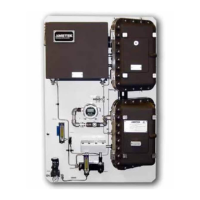6-6 | Model 931S / Model 932S UV Analyzers
Detecting a plug in the sample system:
This is best done by observing the analyzer’s measurement response
time immediately following a Zero. A typical response is in the range of
15–30 seconds. Observe your analyzer regularly to learn what a normal
response time is and keep records of response times after a Zero. Use
the recorded response times as a reference for detecting the formation of
plugs in the sample system (that is, longer response times).
The section of the sample system with the highest risk of plugging is
the sample inlet and the section of the sample inlet most prone to plug-
ging is the Sample Probe Valve. One way to confirm that a plug is in the
sample inlet is to cap the Vent Line (or, optionally, close the Vent isolation
valve) and Zero the analyzer. Plugs in the sample outlet (or vent side) of
the sample system are rare. If an aspirator is used to transport the sample
gas, a plug in the vent system can cause the aspirator drive air to flow
back into the Measuring Cell and, essentially, simulate a Zero Gas Flow or
Backpurge condition.
If the Pressure Compensation option is installed, observe the Cell
Pres(sure) reading on the Cell/Miscellaneous (compensation) parameters
dialog box, and if the reading approaches the Zero gas supply pressure, a
plug is present somewhere in the sample inlet.
To avoid damaging the pressure transducer, do not set the pressure
higher than the pressure transducer rating, either 210 KPAA (30
PSIA) or 0–700 KPAA (0–100 PSIA).
After confirming that the plug is somewhere in the sample inlet, take
all appropriate safety precautions and dismantle the sample system,
starting at the Sample Probe.
NOTE
!
CAUTION

